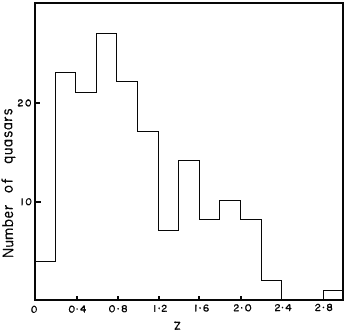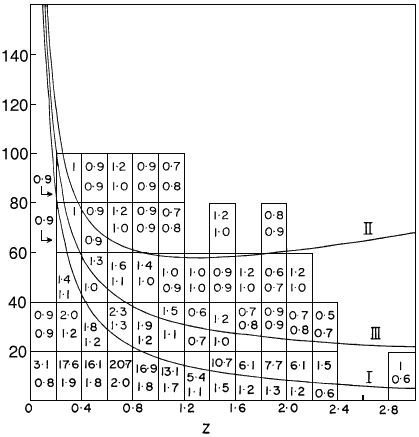
Varshni,Y.P.: 1976, Astrophys.Space Sci., 42, 369.
Also available in Adobe Acrobat PDF format.
Abstract. The envelope function in the largest angular size-redshift diagram for quasars is shown to be a consequence of the distribution of their redshifts and to have no intrinsic physical significance.A few years ago, Legg (1970), using currently available data, made a study of 32 radio galaxies and 25 quasars which are predominantly double in structure. He plotted the angular separations of the source components against the redshift. Curves obtained for the angular size from two world models, namely those of Einstein-de Sitter, and de Sitter, for a source of a fixed linear size of 290 kpc were found to provide reasonable upper envelopes to the plotted points. Macdonald and Miley (1971) studied the structures of 79 quasars with a resolution of up to 3 arcseconds. Miley (1971) made a compilation of the then available data on 127 quasars and from plots of `largest angular size' (LAS) versus the redshift z, concluded that, on the average, component size decreases with increasing redshift. A Euclidean world model with source size of 400 kpc appeared to provide the best envelope. The indication was that the angular size falls off with redshift faster than one might expect for values of the deceleration parameter, q0, as determined from the apparent magnitude-redshift diagram for galaxies. Also, there was no evidence for any change in the slope at large redshifts as is expected from any of the conventional cosmological models. This led to the enunciation of the third paradox of Kellermann (1972) :
Recently, Wardle and Miley (1974) have studied the structures of 39 quasars with the NRAO interferometer at wavelengths of 11.1 and 3.7 cm. The LAS-z diagram is extended to 166 quasars, and the plot is compared to the results from the following three world models for a source of linear size 500 kpc.
(I) Static Euclidean model :
theta = 17.2/z arcsec (1)
(II) Einstein-de Sitter model :
theta = 8.6 (1+z)^2 / ( 1 + z - sqrt(1+z)) arcsec (2)
(III) A variant of (II) in which account is taken of the `ram pressure' for the
containment of extended radio sources; it involves an additional parameter. The resulting
relationship is
theta = 8.6 (1+z)^(6/5) / ( 1 + z - sqrt(1+z)) arcsec (3)
None of the three models provide a satisfactory solution. The only conclusion that
can be made is that (III) appears to be better than the other two.In practice there is a basic difficulty in drawing conclusions as to which is the best curve. Ideally speaking, an envelope function should lie above all the points, which certainly is not the case here. No analytical method has been proposed which could be used as a criterion. The behaviour of any curve has to be judged by the eye alone, which, of course, is subjective and rather unsatisfactory. Also the evidence for the existence of an envelope is based on very few points. The LAS-z envelope is sometimes used as an argument in favour of the cosmological interpretation of the apparent redshifts of quasars. It is important to establish whether or not the existence of the envelope is real or whether it arises because of some statistical or selection effects. We demonstrate here that the observed behaviour of the envelope of the LAS-z plot is a consequence of statistical effects and is just a reflection of the redshift distribution diagram, and that it has no intrinsic physical significance.
We consider here 164 quasars out of the 166 in the total list of Miley (1971) and Wardle and Miley (1974). The difference of two is due to the fact that one of the quasars lies outside the scale of Figure 3 of Wardle and Miley (1974), and for another one, we have been unable to find the redshift. We may note here that there seem to be only 164 points in Figure 3 of Wardle and Miley (1974).

Fig.1.'Largest angular size-redshift' plot for 164 quasars. The vertical axis represents the largest angular size in arcseconds. The numbers indicate the total number of quasars which lie in the respective rectangles. Blank rectangles have no quasars in them. Curves I, II, and III represent Equations (1), (2), and (3) respectively.
We have plotted the LAS versus z in Figure 1. This is essentially equivalent to Figure 3 of Wardle and Miley (1974). However, instead of showing the individual points, we have shown the total number of quasars in compartments having redshift widths of 0.2 and LAS widths of 20 arcsec. The three theoretical curves (Equations (1), (2) and (3)) are also shown. Figure 2 is a histogram showing the number of quasars as a function of the LAS, without reference to the redshift. Figure 3 shows the distribution of emission-line redshifts for the 164 quasars under consideration.

Fig.2.Histogram showing the distribution of the largest angular size (LAS) of quasars.
It will be noticed from Figure 2 that the majority of quasars (126) have a LAS <=20 arcsec. These quasars play hardly any role in determining the envelope function. Also, Figure 2 shows that there is a steep decrease in the number of quasars with increasing LAS. If we select randomly n quasars from these 164, the distribution of the LAS values of these n quasars will be similar to the one shown in Figure 2. If n is large, e.g. about 30, most of them will have a LAS <= 20 arcsec, but we can expect to have a few quasars in the tail of the distribution up to LAS=150 arcsec. On the other hand, if n is small, e.g. about 7, practically all of them will have a LAS <= 20 arcsec. The extent of the tail will depend on the number n. Next consider the redshift distribution of quasars shown in Figure 3.

Fig.3. Distribution of emission-line redshifts for 164 quasars.
It will be noticed that the general trend is that the number of quasars decreases with increase of redshift. It is obvious from our previous discussion that the extent of the tail will also decrease with increase of redshift. We can place our arguments on a quantitative footing by making use of the sampling theory (see, e.g., Cochran, 1963). The mean number of objects of a certain type in a sub-population of size n is given by
E = n A / N (4)
where A is the total number of objects of that type in the total population N. Also,
the variance is
V = n(A/N)(1-A/N)(N-n)/(N-1) (5)
In Figure 4 we show the expected mean number of quasars and the standard deviation
in the various compartments. The upper quantity in each compartment is the mean
number of quasars and the lower quantity is the standard deviation. To avoid non-significant
numbers like 0.12, the tail of the distribution was integrated such that the
last number was about 1.

Fig.4. Theoretical largest angular size-redshift plot, obtained from statistical considerations. The upper quantity in each compartment is the expected mean number of quasars and the lower quantity is the standard deviation.
It will be noticed that Figure 4 is quite similar to Figure 1. In other words, the envelope function in the LAS-z plot is just a reflection of the redshift distribution, and in itself has no physical significance. The result of the present investigation is consistent with our suggestion that there are no redshifts in quasar spectra (Varshni, 1973, 1974a, 1974b, 1975a, 1975b).
The conclusion of this communication was further confirmed by randomly pairing LAS and z values on a computer. Several runs were made. The resulting plots are found to be quite similar to Figure 3 of Wardle and Miley (1974).